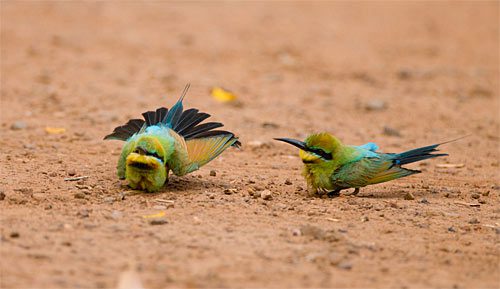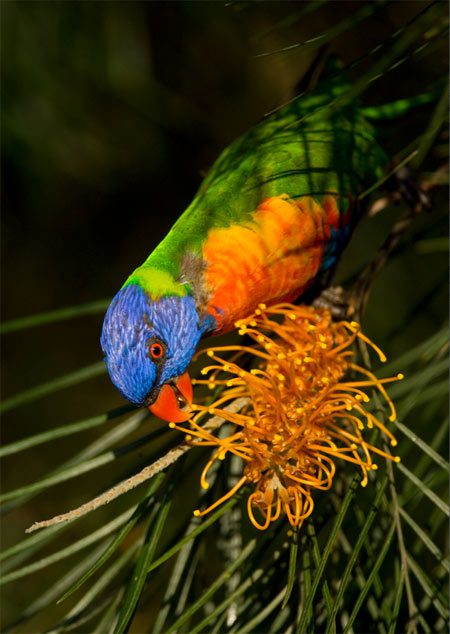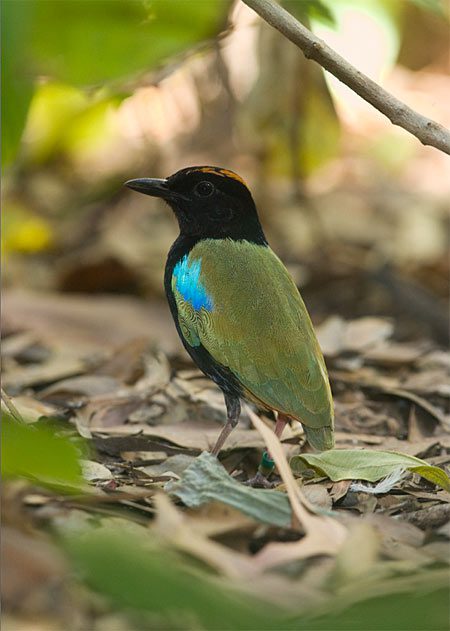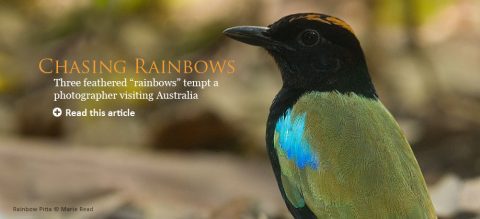Chasing Rainbows: Photographing Australia’s Birds
January 15, 2010
Dust-bathing Rainbow Bee-eaters were Marie Read's first Australian rainbows. Photo by Marie Read. 
This Rainbow Lorikeet was Rainbow Number 2. Photo by Marie Read. 
For Marie Read, this Rainbow Pitta was the hardest of Australia's three rainbow species to find. Photo by Marie Read.
Gunlom Falls, the sign said, pointing down a dusty stretch of washboard road as bad as I’ve ever seen. At the end of that outback track stood a patch of monsoon forest watered by a cascade pouring off the rocky Arnhem Plateau—my final chance to photograph one of northern Australia’s most elusive endemic birds, the Rainbow Pitta.
Two weeks earlier I’d flown into Darwin, Northern Territory’s steamy capital, with my husband Peter, on the first leg of a three-month trip down under. Our first destination was the wild and beautiful Kakadu National Park. For fun, I had set myself a challenge: to photograph the three Australian birds whose names include the word “rainbow”—the Rainbow Lorikeet, Rainbow Bee-eater, and Rainbow Pitta. The first two would turn out to be easy. We’d already found Rainbow Lorikeets— little multicolored parrots that visit gardens, parks, and campgrounds in chattering flocks, clinging upside down to lick nectar from flowers—in Sydney, our port of entry. But the search for the shy pitta, found only in Australia’s tropical far north, would become an obsession. With rainbow #1 already in the bag, we set off.
Howard Springs Nature Park, east of Darwin, was supposedly a sure thing for the pitta. Listen for its whistle, we were told. It sounds like walk-to-work. Off in the distance, we heard the call, but as we followed it into the forest the bird remained a shadowy presence, always just ahead, hidden in the dense foliage.
The afternoon waned, our enthusiasm flagged, and we headed for the parking lot. Right in front of us Rainbow Number 2 appeared: colorful Rainbow Bee-eaters swooping through the air chasing insects in typical bee-eater fashion. We watched, captivated, as they came down to dust-bathe on the ground, shuffling and shimmying around in the dust to clean their feathers.
Next stop was Fogg Dam, and there was the Rainbow Pitta again, taunting us with its walk-to-work call. But it was unwilling to come within camera range, even when we played a recording of its voice. Onward to Kakadu to enjoy other birds.
Now here we were, almost at the end of our trip, and still no photographs of Rainbow Number 3. There was nothing for it but to tackle that bone-jarring road. An hour later we pulled into the campground and headed into the forest. Binoculars at the ready, we wandered the trails, alert to every sound and every flutter of wings. But not one pitta did we find, and as dusk fell my mood turned as gloomy as the darkening forest.
The deep pool at the base of the falls looked cool and inviting, so later on we skinny-dipped by the light of the moon, and I tried to let go of my disappointment. “Lighten up,” cajoled Peter. “You can’t always get what you want.” Ah, yes, that good old Rolling Stones song. How many times I’d sung it to myself in the past to remind me that it’s fine to have high expectations, but sometimes you simply have to lower the bar.
Next morning we vainly tried the forest one final time, then left for Darwin. Near the outskirts of the city was a sign: Territory Wildlife Park. We had heard about this well-known tourist spot, and we had all afternoon—why not stop in for a look?
We mingled with the requisite tame kangaroos and wallabies and stood eye-to-eye with Emus, then noticed the aviaries where various native habitats had been recreated—mangrove forest, freshwater wetland, monsoon forest—complete with the appropriate live plants and birdlife. From one of them came a familiar sound: walk-to-work. And there, not 10 feet away behind a glass wall, was a Rainbow Pitta. What luck! I pushed my camera lens against the glass to avoid reflections, and snapped away. Forget my snobbish aversion to photographing captive birds—I wasn’t about to miss this chance! Finally, Rainbow Number 3.
Next thing I knew there was a tap on my shoulder: “Excuse me, but it’s past five o’clock, and we’re supposed to be closed.” I had lost track of time. Apologizing, I walked past the park staff waiting patiently for me, the last visitor to leave. Unable to suppress a smile, I began to sing to myself, “You can’t always get what you want, but if you try sometimes, you just might find, you get what you need.”

All About Birds
is a free resource
Available for everyone,
funded by donors like you
American Kestrel by Blair Dudeck / Macaulay Library






